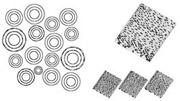July 11, 2006
Simon Elvins' Silent London

Mapping Sound
Simon Elvins is concerned with sound as an ubiquitous force. Through a series of projects he has been documenting how sound is an often ignored dimension of our physical environment. Silent London plots quiet spaces in the English capitol using noise level data. An embossed print shows quiet areas raised up from the paper, bringing them to the attention of the viewer, while noise areas become blanked out valleys. noisy areas raised up from the paper while quiet areas become blank areas of peace. His FM Radio Map serves a dual purpose. On the one hand it plots the physical locations of commercial and pirate FM radio stations broadcasting in London. But circuits conductive pencil lines placed on the back of the map also turns it into a physical interface. Using a modified radio the map can be aurally “navigated” by placing metail contacts on points on the map.
These projects are poetic but ultimately functional. Taking a conceptual design approach (Elvins studied Communication Art & Design at the Royal College of Art), they present numerical data in an aesthetic context. By choosing low-tech materials (paper, electronics) Elvins creates fragile objects whose material qualities belie their sophisticated technical content.
Simon Elvins is concerned with sound as an ubiquitous force. Through a series of projects he has been documenting how sound is an often ignored dimension of our physical environment. Silent London plots quiet spaces in the English capitol using noise level data. An embossed print shows quiet areas raised up from the paper, bringing them to the attention of the viewer, while noise areas become blanked out valleys. noisy areas raised up from the paper while quiet areas become blank areas of peace. His FM Radio Map serves a dual purpose. On the one hand it plots the physical locations of commercial and pirate FM radio stations broadcasting in London. But circuits conductive pencil lines placed on the back of the map also turns it into a physical interface. Using a modified radio the map can be aurally “navigated” by placing metail contacts on points on the map.
These projects are poetic but ultimately functional. Taking a conceptual design approach (Elvins studied Communication Art & Design at the Royal College of Art), they present numerical data in an aesthetic context. By choosing low-tech materials (paper, electronics) Elvins creates fragile objects whose material qualities belie their sophisticated technical content.
Parallel to Elvin’s interest in sound is his fascination with mapping of physical and intangible forces. Both the aforementioned projects are classic mapping projects, while Notation is a more abstract exploration of how sound can be represented visually as marks on paper. Reminiscent of experiments with graphic notation (see Eno etc), the project consists of studies of representations of tonal patterns using pencil on paper.
The Notation project page seems to indicate that these drawings can ultimately be used to produce sound, but no details are available. If so, it would be an inversion of Elvin’s excellent Paper Record Player, where he constructed a functional record player out of paper, complete with its own conical paper amplifier.
(Thanks to TomC. See also Mount Fear.) [blogged by Marius on Generator.x]
Posted by jo at July 11, 2006 09:24 AM
